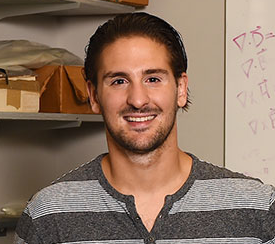Insights on 3D Nucleon Structure through Kaons
Richard Trotta
PhD Candidate - Department of Physics
The Catholic University of America
Wed, September 18, 2019 - 4:00 PM
Karl Herzfeld Auditorium of Hannan Hall - Rm 108
 Nuclear physics studies the origin and structure of atomic nuclei in terms of their basic constituents, the quarks, and gluons. Atoms and molecules would not exist without underlying quark-gluon interactions, which build nearly all the mass of the visible universe from an assembly of massless gluons and nearly-massless quarks. An important aspect of this effort is imaging and understanding the 3D hadron substructure. Traditionally, knowledge has been gathered on the structure of hadrons from studies of their static properties (mass and spin, polarizabilities, form factors) and the one-dimensional quark and gluon momentum distributions underlying them. Probing into the hadron reveals quark and gluon constituents' dynamical motion. They can appear and disappear and all strongly interact. Unlike with the more familiar atomic and molecular matter, interactions and structures in the nuclear matter are inextricably mixed up, and the observed properties of nucleons and nuclei, such as mass and spin, emerge out of this complex system. Exclusive reactions, processes in which deep inside of the nucleon is studied with a highly-energetic photon or electron probe, are a good way to study the nucleon dynamical structure. Exclusive kaon production is of particular interest and in this talk, I will discuss CUA's kaon experiment which ran in 2018/19 at the 12 GeV Jefferson Lab. This experiment will provide L/T separated cross-sections at the highest virtual photon mass to date
Nuclear physics studies the origin and structure of atomic nuclei in terms of their basic constituents, the quarks, and gluons. Atoms and molecules would not exist without underlying quark-gluon interactions, which build nearly all the mass of the visible universe from an assembly of massless gluons and nearly-massless quarks. An important aspect of this effort is imaging and understanding the 3D hadron substructure. Traditionally, knowledge has been gathered on the structure of hadrons from studies of their static properties (mass and spin, polarizabilities, form factors) and the one-dimensional quark and gluon momentum distributions underlying them. Probing into the hadron reveals quark and gluon constituents' dynamical motion. They can appear and disappear and all strongly interact. Unlike with the more familiar atomic and molecular matter, interactions and structures in the nuclear matter are inextricably mixed up, and the observed properties of nucleons and nuclei, such as mass and spin, emerge out of this complex system. Exclusive reactions, processes in which deep inside of the nucleon is studied with a highly-energetic photon or electron probe, are a good way to study the nucleon dynamical structure. Exclusive kaon production is of particular interest and in this talk, I will discuss CUA's kaon experiment which ran in 2018/19 at the 12 GeV Jefferson Lab. This experiment will provide L/T separated cross-sections at the highest virtual photon mass to date
Refreshments served at 3:45 PM
If you have any questions about the Colloquium Series or would like to make a donation please contact the Physics Department, cua-physics@cua.edu or (202) 319-5315.
